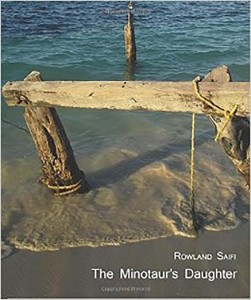By Mary Burger
 The Minotaur’s Daughter by Rowland Saifi takes place in a small, unnamed beach town with a lone second-person narrator who relates the peculiar story of how he comes to live in a sort of reverse exile, left behind after everyone else has gone.
The Minotaur’s Daughter by Rowland Saifi takes place in a small, unnamed beach town with a lone second-person narrator who relates the peculiar story of how he comes to live in a sort of reverse exile, left behind after everyone else has gone.
The town, it emerges, once held an annual festival, both giddy and ghoulish, to commemorate a long-ago event when an unidentified man was found dead one morning on the beach. Though nothing is known about the man—where he came from, why he was in the town, how he died—the few details and circumstances surrounding him are enshrined and fetishistically reenacted. His particular brown jacket and cuffed trousers, the cigarette behind his ear, the red dressing gown and slippers in his leather suitcase, all become costumes and props for the carnival.
At the center of the dead man’s story is the cipher, a coded message on a scrap of paper found in his pocket. The message, as inscrutable as the man himself, tantalizes with its promise of information just out of reach. The message inspires a contest held every year during the festival, with townspeople submitting solutions for the code. Each solution is ceremoniously considered by the judges, and each solution, year after year, is dismissed as a failure. The contest and the festival continue unchanged in a cheerful mix of nostalgia and riddle—until the year when the narrator, a schoolboy at the time, in a casual and unassuming effort, cracks the code.
We never learn the content of the message, of course, only its decisive effect: as the message is revealed, the townspeople abruptly abandon the festival, the town, and the narrator himself:
the panic spread, the officiates condemned you, and people you couldn’t place, neighbors, teachers, friends, avoided you until the town lost its head and left, the cars crossed the bridges, the shops abandoned, a hasty retreat, an escape from a town, from you,
Did something in the message shatter the town’s innocence? Did the boy’s simple solution embarrass everyone to the point of fleeing? Was the unsolved mystery, with its promise and possibility, the only thing that had sustained the town? Decoded, the message only becomes more enigmatic.
The Minotaur’s Daughter is told through fugue-like repetition and variation infused with unrealized possibilities. “You have a second self,” the narrator declares at the beginning and many times again as he describes life in the empty town, sifting through the abandoned houses, driving and crashing the cars left behind, all the while longing to undo the catastrophe of his accidental decryption. He tells his story with affection and wistful detail, with the deliberateness of someone who has nothing but time ahead of him, with the painstaking care of someone who does not want to leave anything out or get anything wrong, lest his words shatter the air again.
Just before he cracks the code the narrator befriends a slightly older girl, the only other character in the story. She and her friends offer gentle skepticism about the dead-man reenactments and the town’s enchantment with its own legend. Even so, she flees from the loss of the mystery just like everyone else:
and you wonder why no one has stayed, why not even she stayed or her friends, who were for a while your friends, who said they didn’t care about the celebration, who felt it false and forced, and antiquated, and although they were older than you, she, did not stay, the failure of mysteries,
In The Minotaur’s Daughter, the monster in the labyrinth is not slain and the hero does not find his way back out. The mystery doubles back on itself again and again, and what we are lost in is the tangle of our own thoughts, sorting out the rumor from the illusion and the truth from the real truth:
but you knew a greater secret, that day, sitting on the beach, that day so much later, watching the seagull walk past, that it wasn’t some conspiracy, a spy game, a matter of international intrigue, you found there was no minotaur at the center of the labyrinth, only the dead man and the blue that wasn’t blue, that drew the man here, that attracted him, that drained him and left him gazing out to that sea, the wine dark sea that others missed while they swam,
The book draws from the true story of the Somerset Man, an unsolved case of a man found dead on a beach in South Australia in 1948, with possible links to cold war espionage. In Saifi’s hands the mystery becomes more charmed, anachronistic and timeless, a fairy tale caught in the enigma of language itself. How do words mean? Why do they have the power they do, to hold us together and drive us apart? The answers, we know, are life-and-death.
Saifi’s next book Lit Windows is forthcoming from Spuyten Duyvil in 2016.
The Minotaur’s Daughter
by Rowland Saifi
Spuyten Duyvil
July 2014
ISBN 978-1-941550-06-9









